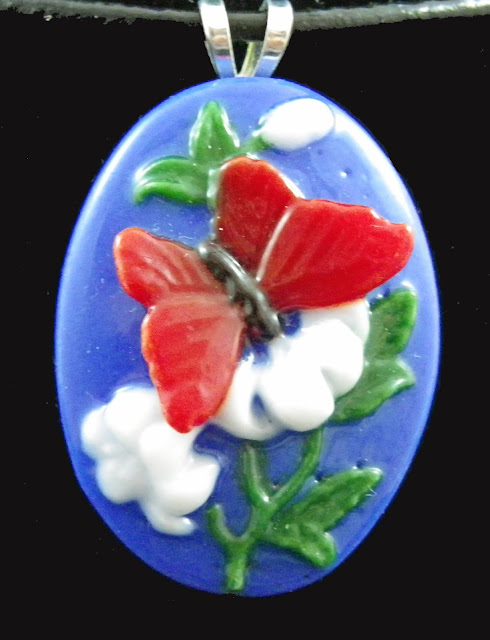Welcome to Peak Heart Glass Art. Lets start off with a few picture of the fused glass work I have done. All glass is System 96 (S96).
Mountain Plate
I used S96 crystal blue glass for the background. White Iridescent for the mountain peak and aspens, Green S96 Fusers' Reserve at the bottom. The frit is a mix of several yellows, oranges, and a little red. The moon is a piece of dichroic on clear.
Black and White Ruffle Bowl
A piece of black and white Fusers' Reserve glass capped with a piece of clear slumped into a large ruffle bowl mold
Carnelian Ruffle Bowl
This was also a piece of Fusers' Reserve glass capped with clear and slumped into the large ruffle bowl mold
Blue and Green Butterfly Plate
The background is once again a piece of Fusers' Reserve glass. The butterflies were made with glass powder using the Freeze and Fuse technique.
The Lake Plate
The base is 2 layers of clear glass. The center is a piece of Fusers' Reserve glass cut into pieces with dichroic frit in between them. The outside is a Carolina Frit mixture. The final result is a tack fuse into a basic plate mold.
Ice Cream Dish
A piece of Fusers' Reserve tack fused to another square of clear glass. Clear frit is sprinkled around the edges. I also used a "foot mold" for the base.
Freeze and Fuse Butterfly Pendant
Created with different glass powders carefully put into a silicone mold. It is then frozen and taken out of the mold onto a kiln shelf and tack fused.
Pot Melt Clock
This is one of the first pot melts I did. It is almost a half inch thick. The numbers were stenciled on using intense black china paint.
Aspen Plate
Blackberries and Cream opal art glass capped with clear. The trees are white Irid glass and the frit is a combination of Carolina frits.
Mermaid Bubble Pendant
I used Azure Blue Unique Glass Colors Artisan paint between 2 layers of clear glass and then added black decals.
Silver Blue Dichroic Pendant
Silver Blue dichroic ripple glass capped with clear.
I hope you enjoy my pieces. I will post more as I make and photograph them. I am planning a tutorial on how I use clear glass powder to help eliminate most bubbles between layers of glass.


























